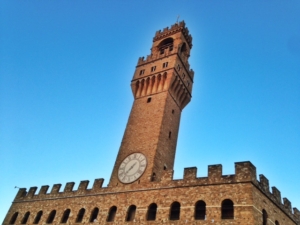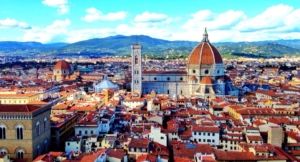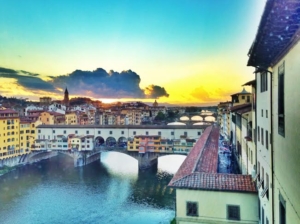
Palazzo Vecchio
No, it’s not the wine. It’s not jet lag; I’ve been here two weeks now, I’m adjusted. It’s not even the sea of people rushing by me at any given moment. OK, maybe it’s a little bit due to all of the hordes of people here for the same reason I am — all that art. More so, it’s the information, the stories of and about the art, the artists and the patrons.
It’s a good kind of spinning. I wouldn’t have it any other way.
As I learn more of the history of Florence and view it for myself, I gain a greater understanding of the city and its art movements. It seems to sweep you up and carry you along on its journey.
Think of the Renaissance as a giant bulldozer making way for everything that came after it. Plowing away the Dark Ages and letting in the light. It’s a kind of foundation upon which all later art was built.
I also think of the Renaissance as an explosion, like the Fourth of July happening everyday for 200 years. All here in Florence, with the backdrop of the River Arno.
Again, we have to be careful not to get to over the top over the whole thing, not putting these people on pedestals, for fear of shriveling in the shadows while imagining a grandeur so far removed. Still, to view and learn the history is, I like to think, a duty of artists. To know the who and why of this path that was bulldozed for me to walk through.
Today, I did that at the Museo Stefano Bardini. Stefano (1836-1922) was an artist turned art and antiquity dealer, one who greatly influenced the trade and auctions in the United States. It’s a lovely and quiet museum, with lovely things. His passion was wide, and his trading encompassed everything from Roman ruins to weapons and paintings.
I was most impressed by a Donatello (early Renaissance): It’s a Madonna and child that surely must be the first collage painting. It’s made of wood, plaster, glass and even leather mosaics. It delighted me think of this master wanting to “play” and explore the possibilities in this way. Also captivating: a room of drawings by Tiepolo. Delightful works created from a masterful but free hand.
After a short break to recharge, Benedetta and I were off to the Palazzo Vecchio, the city hall turned Palace of the Grand Duke of Tuscany, Cosimo de Medici. When the Duke and his wife Lenora moved their residence from the Medici Ricardi Palace to here, they hired Vasari to “redecorate,” raising the roof of the Hall of 500 by 20 feet and plastering the room with paintings from the ceiling down. It’s a grand celebration of Florence, the victor of Tuscany. Here again, we have art as a reflection of the times. Florence has defeated all of Tuscany, and I, Cosimo de Medici, am grand duke of it all: Let’s show the world. Keep in mind, this is all before Facebook, so you had to get the word out somehow (wink). No cameras, so art played this role as well as to tell a story.
The palace goes on with Lenora’s chapel by Bronzino being a highlight. So much symbolism, stories and history all told in the beautiful craft of art.
I need some fresh air. Luckily, you can climb the tower of the Palazzo and before you know it, your head is lighter. The air swirls about you and there is no more information to take in, only the material beauty of the landscape. Sigh. A beautiful way to wrap up a week of art history. And a deep bow of gratitude to Benedetta Natali for making the city come alive for me.

The view from the Palazzo Vecchio tower.
Insider secret: The Uffizi and Accademia museums are open until 8 p.m. on Tuesdays and Fridays, and they are very quiet at this time. Last night, I celebrated my week of art history with a nighttime visit to the Uffizi. Here are the sunsets as I strolled the halls, almost by myself. Bring able to meditate on the art without the masses is so relaxing. It’s an experience not to miss.









Nice job on all these posts love!
>